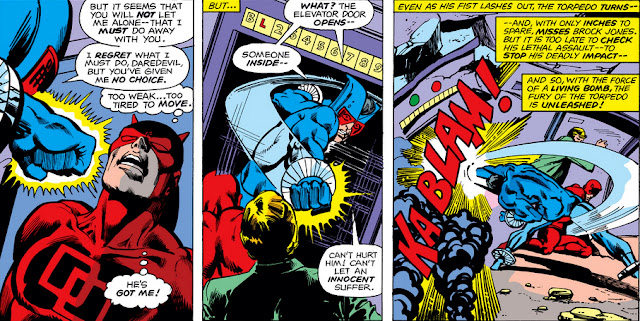In just about any comic that featured the incredible Hulk described as going "berserk," that would be no great stretch of the imagination for any
Hulk reader, given the character's fits of rage. In addition, since that rage brings about an increase in the Hulk's strength, it doesn't come as a surprise when the level of destruction of a given area (or the punishment of a foe) becomes a scene of carnage and devastation as a result. But when a book such as
What If makes such a claim, a series where the worst case scenario often becomes reality (that is,
alternate reality), you can almost depend on the likelihood that even for a creature of rage such as the Hulk, things are going to get as bad as bad can get, as the Watcher will attest to in this mid-1984 issue.
Compliments to artist Bill Sienkiewicz (and his letterer) for the story's stunning cover.
Written by Peter Gillis with art by Ron Wilson, this would be the last issue of What If that the Hulk would appear in as its main character, having been featured as such in four prior issues throughout the first volume of the series. Given the Watcher's introduction, it's apparent that whatever change in the Hulk that affects his behavior to such a degree will occur at the point when Bruce Banner first transforms into the man-brute--ergo, it's fair to assume that something about the gamma bomb explosion that irradiates him is different than we remember. And that indeed turns out to be the case, as we join the doctors investigating the level of radiation exposure in not just one patient this time, but two.

In this reality, Banner failed to reach the protective trench with his young charge, Rick Jones, which leads to both of them being exposed to the detonation of the gamma bomb test. And so when Banner experiences his initial transformation that will change his life for the worse, in this reality Rick has an empathic reaction to the changes in Banner's mind as the creature who would become known as the Hulk breaks out of the facility.
All too quickly, just as it happened in our reality, the men under the command of General Ross witness the capabilities of the monster that will be named the Hulk--while our doctors discover a figurative lid being clamped down on the entire developing situation, which will unfortunately prevent their input from reaching those who are most in need of understanding just who and what the Hulk is.
Gillis has brought in Maj. Glenn Talbot--a character who for us didn't join the fold until the Hulk's second act in Tales To Astonish--somewhat earlier than his original appearance, though just as committed to his duty and to Ross.
And so we see the battle lines being drawn by these officers who are now dealing with the threat potential of a powerful, unknown intruder. But with Rick also now having a telepathic connection with the Hulk even from his sickbed, the circumstances here will change dramatically for all concerned--particularly for Ross, who is now on the path to making an enemy obsessed with his destruction, an enemy the likes of which he and the men under his command have never known.



























